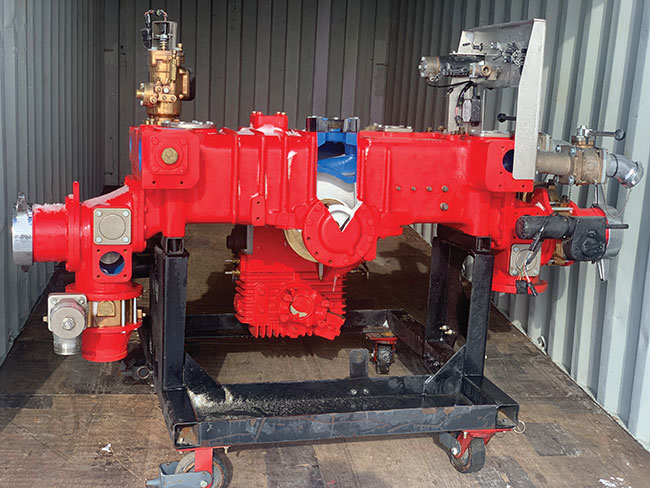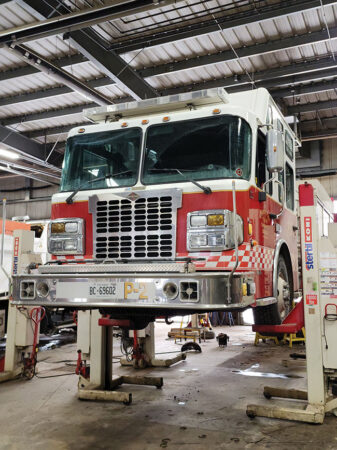
Features
Training
Canadore rolling out EVT training
This partnership program hopes to foster the training and development of more emergency vehicle technicians.
March 3, 2023
By
Laura Aiken
 Fire pump prop that is used for teaching.
Photos: North Bay Fire Department
Fire pump prop that is used for teaching.
Photos: North Bay Fire Department Canadore College, based at North Bay, Ont., is looking to help alleviate the shortage of emergency vehicle technicians (EVT) and maintenance challenges facing departments through an EVT training program now being offered in partnership with the Fire Department Safety Officers Association (FDSOA). The next week of classes starts March 27.
Jason Whiteley, the fire chief in North Bay, was involved in coordinating the partnership with Canadore, and North Bay serves as a partner itself to the training. He sees a need to address the shortage of EVTs as being critical on two key fronts. One, the chief needs to account for the liability of a down truck. If the vehicle attends a significant incident, hasn’t been maintained and a catastrophic failure ensues, there could be litigious consequences for the municipality.
Terry Stewart, vice-chairman for the FDSOA, said there is a “huge liability crisis right now. The fire service is in a bit of a crisis with getting new trucks — likely take up to a couple years coming out of covid with manufacturing troubles and parts supply problems — we don’t have trained-up technicians and we’re back to extreme maintenance as that new replacement truck isn’t going to come when its due.”
Two, but by no means secondary, the safety of firefighters is paramount. The vehicle they respond in needs to be “roadworthy and fit for duty.” A brake or steering failure could result in a tragic accident. Firefighters need to have confidence in their equipment and the mechanics servicing it, Whiteley said, and that can easily be lost if there is a malfunction due to a lack of adherence to maintenance standards. The fire service does a great job of keeping vehicles shined up and looking great, he said, but a 20-year-old vehicle is still that old and it’s going to get “old-age-creep,” thus becoming more prone to a possible failure.
Rich Marinucci, executive director for the FDSOA, notes that training is expensive, but not training is even more expensive when it comes to making mistakes.
“If something goes wrong and you can’t demonstrate that you were the right person to perform that service, and you didn’t do it to acceptable standards, you’re going to have some explaining to do, regardless of the outcome, but that’s even irrelevant to how we look at it from a fire department safety officer’s perspective. We can’t start our job unless we get to the scene safely.”
Whiteley said he is fortunate to have a great fleet division with very good, competent technicians, but knows that is not the case for many small departments who won’t have a fleet department or fleet technicians and must get their service elsewhere nearby by someone who may be able to fix the truck, but may be lacking in experience with the electronics, hydraulics, pump and NFPA standards.
“NFPA changes their standards every four years, and we need to keep up with how the technology is changing. A 2023 truck is going to look awfully different than a 20-year-old truck.”
John Ouellette, fleet manager for the City of North Bay, said the key need for technicians is in the specialized training, especially from Original Equipment Manufacturers (OEMs) or NFPA. Training is critical because these are very specialized pieces of equipment and NFPA standards are very precise.
“This project we have with Canadore, I think it will be a really good micro-credential for training young apprentices and younger mechanics so they move up in the trade. That’s where our partnership with Canadore comes in as a specialist for training. And now you have electric vehicles coming that are critical response vehicles…they are very specialized that’s why the training is so critical.”
He emphasized that North Bay has a great relationship with the OEM, but it’s six hours away and time is of the essence. Distance to an OEM is very likely a challenge for lots of rural communities across Canada. He noted that when you are in northern areas, bringing a vehicle to an OEM could be a 10 to 12 hour drive with a significant travel cost to consider.

Fire truck on a lift.
Training at Canadore
Stewart said the program Canadore is offering was developed six years ago in conjunction with the EVT Certification Commission and he sits on their testing board. Canadore has become a testing site, and Stewart noted that is not an easy feat.
“This program is not any different anywhere in North America. I travel around to deliver classes and find there is a huge disconnect between operators, operations, fire and fleet. There always seems to be a little bit of a bantering in there.”
The four-day classes offered at Canadore through the college’s Industry Liaison Canadore Continuing Education and Corporate Training department, cover F1 to F6 levels of training plus M-1 and M-2 management level courses. A fifth day is required for testing. During the week of March 27, Canadore will offer Level 1 EVT, which covers F-1 (maintenance, inspection and testing of fire apparatus 1) and F-2 (design and performance standards of fire apparatus). Both are designed to meet the standards of NFPA 1911. These classes are not just for technicians, but also helpful for spec writers buying fire vehicles and fleet managers looking for a better understanding of what the back end looks like. As the cohort builds, the next levels described will be offered.
Level 2 EVT covers F-3, fire pumps and accessories as set out in NFPA standards 1901 and 1911. This class covers all makes and models of pumps and includes a hands-on experience combined with theory portion. Level 3 EVT covers F-4, fire apparatus electrical systems to provide a clear understanding of electricity as they relate to fire apparatus and ambulances. Level 4 EVT covers F-5, aerial fire apparatus as prescribed in NFPA 1901 and 1911 and focuses on understanding how to create a sound maintenance and testing program. Level 5 EVT covers F-6, Allison automatic transmissions, including servicing, maintenance, diagnostics and troubleshooting.
Whiteley said there needs to be a bigger awareness on the importance of EVTs and the training the FDSOA is providing.
“By teaming them [the FDSOA] up with an institution of higher education with a great reputation and motor coach mechanic program, they can continue to help develop that curriculum for the electric vehicles and everything else that’s changing. Giving credence to this program with a micro-certification is significant and there is an extreme shortage of trades people. For some reason we’ve become a society that’s turned its back on the importance and job security of trades.”
Donald Kerr, industry liaison for Canadore, said there are lot of people coming to Canadore that have degrees but not the practical skills to apply in the job market. His conversations with people lead him to believe that many aren’t making the investments in apprentices that they need to. There has been talk of the EVT shortage for a while, and concerns about investing in training and then having the technician poached by someone else also remains, but Kerr noted that this concern over poaching is only so high because of the shortage. He sees a demonstrated widespread need for training in the fact that the March course registration is coming from unexpected places like southwestern Ontario all the way to as far flung as the Yukon.
Kerr said Canadore seeks to build its internal capacity with local trainers in North Bay to be able to offer an EVT course three to four times a year. In becoming a regular delivery agent for this training, he said people will know what to expect and can plan and budget for it. The school has preferred hotel rates and the possibility of offering student residences depending on the time of year to keep the training economical in tight budgetary times. They also offer economical catered food service.
The partnership between Canadore, the FDSOA and North Bay is a new addition to the training scene that hopes to alleviate the shortage of EVTs, a real and pressing challenge impacting the Canadian fire service nationwide.
Print this page
Advertisement
- Ontario expanding cancer coverage for firefighters
- Belleville, Ont. fire chief stepping down, taking over in Kingston